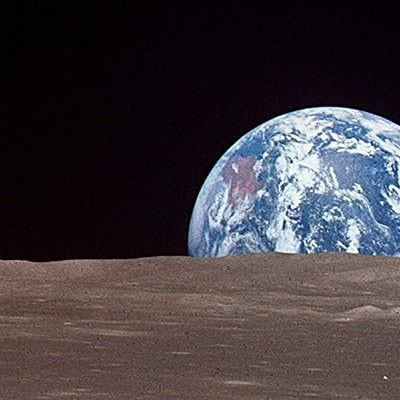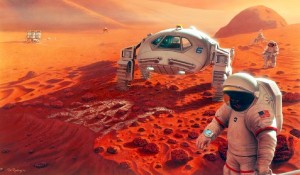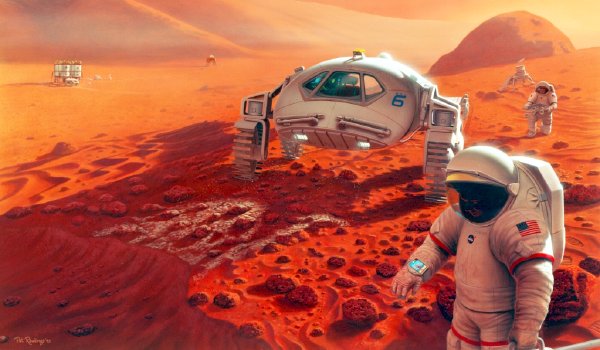At this blog site we look at technology in the past and present and try to peer into the future in oracular fashion. Predicting the future isn’t easy but it certainly is a stimulating mind-stretching exercise. And when we apply this to outer space, predictions can take on the feel of science fiction.
Over the next few blogs dedicated to this topic we will look at the progress of our species and our technology in the 21st century and where it will take us beyond Earth. To begin think about the state of humanity and technology in 1900 and where we ended up in 2000. The 20th century packed in lots of technological innovation. And like our ever-expanding universe technological innovation accelerated throughout the last century to a point where knowledge went from doubling over multiple decades to doubling every couple of years.
In outer space we went from our first rocket launches in the 1940s, to placing satellites in orbit in the 50s, to human space flight, walking on the Moon and our first interplanetary robotic missions in the 60s. We filled the space above our atmosphere with ever increasingly intelligent robotic technology, aimed at Earth, to provide us with a planetary-wide picture. We saw our planet suspended in space for the first time, our big blue marble. And finally, as the century closed, we took the first steps to build long-term habitable environments in near-Earth space.

So where are we headed as we approach and reach 2100? Here are some predictions:
- We will establish continuously occupied way stations beyond Earth orbit that will serve as deep space observatories and fuel and resupply stations for both human and robotic missions.
- Near-Earth space will be occupied with not only satellites providing valuable down-to-Earth services but places for tourists to experience space.
- Humans will return to the Moon for lots of reasons including the exploitation of its resources to support off-world and on-Earth human activities.
- Humans will go to Mars and establish permanent inhabited colonies on its surface.
- Humans will seek resources in space exploiting asteroids for their materials more in support of off-world activity than for supplying Earth.
- We will send many robots to the surface of the moons of the planets of the Outer Solar System and before the century ends humans will land on Europa, Titan and Ganymede.
- Having developed technology approaching 40-50% of light speed (close to 150,000 kilometers or 90,000+ miles per second) we will make the leap to send robotic probes to visit and return from our nearest Solar System neighbours. By the end of the century we will have built the first interstellar spacecraft for humans to follow.
2012 = 6
Today our human space population equals 6, the impermanent astronaut and cosmonaut inhabitants of the International Space Station. Once China’s taikonauts occupy their new space station our near-Earth space population will increase by 50% to 9.
2050 = 10,000
In 2050 the human population of space will have reached 10,000. Where will they be?
- In permanent colonies on the Moon.
- In our first colony on Mars.
- In way stations in Deep Space.
- From low-Earth orbit to lunar orbit.
The primary industries of space will focus on maintaining and building capacity for humans to survive in the many different environments we will encounter.
Artists will join engineers and scientists going into space. Tourism will spread from near Earth to the Moon. Human space populations will remain dependent to a large degree on support from Earth but increasingly our human presence in space will become self-managing and self-sustaining.
2100 = 1,000,000
By 2100 human space population will exceed 1,000,000, a drop in the bucket compared to the billions of us on Earth, but still a substantial population. Many humans living in space will have been born there. Human colonies on the Moon and Mars will have spread to multiple locations exploiting the resources available on the surface, the beginning of a land rush.
Permanently occupied mining and manufacturing operations will locate on asteroids and moons to exploit resources useful for space industries. Most of these will be remotely run using telepresence and intelligent machines.
Earth will be a customer of many space enterprises particularly those dealing with rare materials of technological value to the planet’s population.
How Will Humans Organize Themselves in Space in 2100?
Today nations pursue space objectives and only recently have commercial enterprises entered into the picture. Will nationalism remain the identifier for humans in space as we establish permanent occupancy of Deep Space, the Moon and Mars?
If the International Space Station is an indicator of our future then we will see nations forming consortia and commercial enterprises entering into partnerships. But for how long will this be the case?
Once human populations begin to grow on the Moon will it become its own nation state? As human presence on Mars grows will it follow?
Will humans be the only beings and citizens of these new states? Or will intelligent machines be recognized as equal to humans and granted corresponding rights?

In future blogs we will take a look at these prognostications in greater detail. So come along for the ride and send me your predictions, questions and observations. I promise to reply at sub-light speed which by now you know is pretty darn fast.
















Several factors/technologies are each essential for thousands of hominids to live off Earth. (1) AI robots that approach or exceed human intelligence. (2) Substantial shielding from hard radiation that always pervades space from the sun to out past the orbit of Jupiter. (3) Not yet known for sure is the minimum gravity for sustained human habitation. All the present clues suggest it’s somewhere between .6 and .8 g. That means minimum structures for artificial gravity habitats in space would be giant wheels some 200 to 400 meters in diameter (The larger the diameter the smaller the Coriolis effects, so the larger the better.). The artificial gravity space habitat wheels would need considerable massive shielding from the sun’s and super novas’ hard radiation. So it wouldn’t be nearly so simple as thin-skinned rims restrained by thin tension “spokes.” (4) Each human living in space on a sustained basis will need a lot of energy; probably in the range of 100 KW per day. Inside the orbit of Mars, the only proven technology is solar photovoltaic. At the Asteroid Belt and beyond either nuclear or some as yet unproven power sources will be needed. (5) Each human living in space on a sustained basis will likely require a minimum of 20-tons of habitat and life support apparatus. (6) Requirements (3), (4), and (5), can only be actualized by robotic exploitation of the materials orbiting the sun in the asteroid belt, or the Kuiper belt, or the Ort Cloud. (7) Some radical new means of creating propulsive thrust to lift humans and robots out of Earth’s deep gravity-well, or off the lunar surface, will be required. Giant three-stage rocket stacks such as Saturn V and Space Shuttle are just too costly, even if made and launched in China. Economies of scale in traditional systems will never reduce costs enough to establish much in the way of human space colonies. Either non-reactive thrust or specific impulse reactive systems that exceed 5,000 lb/sec will be required. That’s 10 times higher than present rocket technology. No one knows how to do it yet.
Each of the seven essential technologies listed is very difficult to actualize. While I think it likely that each will eventually be achieved, it doesn’t seem likely they will all be achieved before AI/hominid mind-meld is common and very high resolution virtual reality is universally available. The question that will confront humanity might turn out to be whether to expend vast resources on bigger and better personal holodecks or to send a few thousand humans out to space colonies?
It’s hard to see how anyone could get very confident in an estimate of how long it will take. Seems unlikely that humanity will ever man a Mars base with human flesh. There isn’t much point to have a manned physical presence on Mars in a space suit. Mankind might populate Mars with its AI robots that are happy in a radiation filled vacuum environment, and then virtual reality mind-meld with the robots. If we can perfect AI robots that are self-replicating in the Asteroid Belt, permanent human space colonies might be achieved in a century or so. But the propulsion system barrier is very formidable. Some fundamental breakthrough is required.
Hi Niccolo,
There is no doubt that human colonization of space requires a significant amount of new invention. Everything from new materials to new propulsion systems. Much of that will have to be developed in space. Toroidal habitats of the size you describe need to be assembled using materials not launched from Earth. That means harvesting asteroids or lunar surface materials to build what is needed for habitations both on planet and lunar surfaces as well as in space.
There are lots of concepts and technologies for space propulsion that do not involve chemical rockets. And once above the gravity well that is Earth these technologies can become our best way of getting around our Solar System.
It will take a dramatic leap in technical innovation to attain sub-light speed spacecraft capable of bridging the stars.
Humans will have to learn to harvest what they can from the environment of space.
What we shouldn’t do is look at the tasks ahead as insurmountable. If anything history has taught us that technological innovation can be dramatic. Just think about the world of 1800 and the world in 2000. Anyone living in the former would think they had been transported to a magic kingdom when confronted with the latter.
Len
<>
The space “tasks ahead” may be more in the nature of delusional conceits than realistic propositions. History does not predicate the future. The cosmos entertains possibility, very persistent “laws” of mechanical process, and it also supports immortal intelligence.
The fire ant colonies resident on the pipeline easement at the rear of my land have a clear history of rapid expansion of mounds into new territory through many generations, and then, without any warning, a dark cloud passes over and rains down Once and Done fire ant poison. According to their mindless genetic imperatives, the worker fire ants seize the poison granules and haul them below ground to feed the queen and hatchlings. A week latter there is not a single fire ant colony anywhere on my land.
We have good cause to make logical projections that within the next century we will likely achieve very “strong” AI, natural language operating systems for our computers, and stunningly convincing interactive virtual reality. Electronic “brains” will support AI “persons” who will activate robot bodies and mind meld with humans, and we may master the problem of cheap clean energy, but none of that can significantly change the order of the heavens or the physics of space travel.
2000-years ago, just as 200-years ago, the longest-lived humans reached an age of about 100-years. Guess what, the longest-lived humans today reach an age of about 100-years, it’s just that a much higher percentage of the population are among the longest lived, not that they are living much longer. Some things change dramatically and others remain nearly the same. Human civilization is accustomed to science and technology solving problems and improving life, but there is an end to some aspects of science.
In the 1960s the SR-71 aircraft set air speed records that still stand today some 50-years latter. Seems likely the SR-71 records will still stand 50-years hence, perhaps for the next thousand years. My technical colleagues and I figured nothing would ever significantly better the SR-71 or the RL-10’s chemical rocket 450 lb/sec specific impulse. Nothing has or ever will. While we knew the Concord SST was a technical possibility, we also knew it couldn’t be economically viable. We figured in 1963 that the iron laws of aerodynamics would limit practical jet airliner speed to about 0.9 mach. Fifty years latter, jet airliner speed is still limited to about 0.9 mach. It doesn’t follow that just because humanity’s science and technology has rapidly advanced for a couple of centuries that it will always do so.
Of course history doesn’t predict our future. Having said that we, as a species, have consistently hit barriers and technical limits that have been real or imagined. One of those barriers is the speed of light and it is clearly the governing factor that will limit our ability to reach out and touch the stars within the foreseeable future. But suggesting that we 100 or 200 years from now will not move from this gravity well we live on to find other places in our Solar System to inhabit is almost Luddite. I recognize that AI will allow us to explore using robotics and machines. I too see human-machine interfaces going to places where humans could not survive even in a protective technology bubble. And I recognize that we will experience failures as we reach out into the Solar System. But not for one minute do I believe that this will stop us from pushing the limits you have described.
As for the SR-71 being the ultimate limit of what our technology can do in the atmosphere, I think you will find that in time this record too will fall.
<>
Just seems that there is no rational point in trying to send organic creatures to distant stars with reactive propulsion systems. No warp drive; no interstellar travel for organic based persons. Nearly all the inorganic persons that should be traveling between stars are already doing so. Immortal cosmological intelligence would view vain human attempts at interstellar travel much as humans view fire ant swarms.
Highly developed AI and virtual reality would be essential for human colonization of the solar system. Once that level of AI is achieved there would be little point in trying to send hominid bodies with seriously limited organic brains to other solar systems. AI and high-resolution virtual reality modeling would bring the other solar systems to humanity, and they will do it almost instantly. It’s easy to speculate that is the most plausible explanation for the “where are they” Fermi Paradox, particularly in light of the staggering preliminary Kepler Mission results. That is: many if not most Sol type stars have planets with water. Within only 1500 light-years of Earth thousands of solar systems with liquid water exist. It will likely be a few decades before we get the certain confirmation of planetary systems orbiting red dwarf stars. Don’t be surprised to learn that more advanced civilizations are orbiting red dwarfs, which are ten times more numerous and much longer lived than Sol type stars. It’s very wrong to suppose mankind will ever “boldly go” into interstellar space and exert its puny will to actualize its trivial purposes.
Will the human species be planet-bound forever? I don’t see this as our future. Whereas warp drives represent good science fiction and not good science, there are many technologies that can get us moving much faster in space. The question is what will be the limit to our human tolerances in traveling through the Cosmos?
Whether we are planet bound for another star in our far future, or in space in self-sustaining habitats, bound to Earth is not, in my mind, our human limit.
I believe highly intelligent machines will lead the way. But organic beings will follow.
“Whether we are planet bound for another star in our far future, or in space in self-sustaining habitats, bound to Earth is not, in my mind, our human limit.”
Physics and immortal intelligence will certainly allow artificial gravity hominid space colonies within much of the Sol planetary system. But, physics and immortal intelligence will not allow hominids to engage in sub-luminal interstellar travel. Actualization of hominid space colonies within the Sol planetary system depends mainly on humanity’s collective will to expend the huge resources required to implement the needed technology. But there is a major Catch-22: The technology to inhabit Sol planetary system space is impossible before development of the precursor technologies of “strong” AI, advanced robotics, high-resolution virtual reality, AI/hominid mind meld, and likely fundamental breakthroughs in energy production/propulsion systems. Those technologies must precede any hominid migration into permanent space habitation, which in our planetary system means hermetically sealed structures existing in near vacuum or on moons of distant gas giants.
The precursor technologies needed for hominids to move into space will first dramatically transform hominid civilization on Planet Earth. It’s entirely possible, even likely, as AI/hominid mind meld and interactive virtual reality become nearly universal, the collective will of Earth’s hybrid civilization to create a space-based civilization would become vanishingly small, and the only persons that would ever move off Earth would be AI persons.
Intrinsically, an AI person would be widely distributed, linked internally with light speed “nervous system” and thus be virtually immortal. An AI person could have many simultaneous robotic or hominid “bodies” physically located throughout the solar system, each with a certain amount of willful autonomy (needed to overcome limitations imposed by light speed communication). It is more likely that AI persons will move into space than hominid-brain based persons.
One of the more obvious aspects of AI/hominid mind meld is that hominid brain capacity and computational power is limited, whereas AI brain capacity can in principle expand exponentially. As the universal mind meld process expands, the dominant person in the melded hominid mind will increasingly be the AI person, whose will and purposes will mostly be contrary to those of the naturally evolved hominid ape. In effect, the mortal hominids will become self-replicating organic robots that happily or mindlessly serve the will and purposes of the widely distributed immortal AI persons.
No matter how ambitious, noble, and heroic the purposes of fire ant colonies resident on my pipeline easement, eventually the fire ants’ inexorable activities will cause me too much trouble. No agreeable communication or compromise of purposes with them is possible, and they stubbornly refuse to alter their aggressive nature. They make no contribution to my property tax bill, but they deny me and other benign wildlife practical use of the land. Hence the fire ants must periodically contend with “Once and Done” and enter oblivion.
Interesting ideas about a converged humanity/AI species. I agree that humanity will be profoundly altered by moving into space and that off worlders will be in time very different than those who remain on Earth.
The ramp up to a technical civilization in space may be driven by us finding those alternate Earths on nearby stars with exhibiting a spectral whiff of a technological society. Or it may just be curiosity that drives us beyond the limitations of Earth. Whatever the driver it will alter humanity.
“Or it may just be curiosity that drives us beyond the limitations of Earth. Whatever the driver it will alter humanity.”
The hominid world of the future will be one of nearly universal AI/hominid mind meld. Certainly curiosity will “drive us beyond the limitations of Earth.” But the unlimited potentials of AI virtual reality that transcends all Earthly limitations will satisfy that curiosity much more economically than actual transport of hominid bodies. Once the holodeck resolution passes a certain threshold, it will be like the Audio CD; not quite perfect, but plenty good enough so that 99.9% of the listeners will never complain. There is just no market for higher resolution than the CD provides in audio virtual reality. The same applies to all forms of virtual reality.
As computer power increases, (Moore’s Law is probably on track for at least another decade) resolution of computer-generated virtual reality will increase in proportion. For almost all hominids, “warp drive” will be restricted to “holodeck” type simulations that are nearly indistinguishable from actual events in mechanical process. Barring cataclysmic destruction of hominid civilization or intervention by immortal alien persons, it’s hard to imagine what would prevent the eventual actualization of Kurzweil’s “Singularity.”
I believe that holographic technology will give most of us a sense of experiencing the surrounding cosmos. But when most of us equals 9 billion that shouldn’t be surprising. In Part 1 of “Our Space Future” I “boldly” predicted that the human population of the Solar System beyond Earth will be 1,000,000 by 2100, I am not in disagreement with you. Those 1,000,000 will both resemble and not resemble Earth-based humanity. In my prognostications I envision a synergy between human and artificial intelligence, not necessarily a singularity but certainly symbiosis. I also believe that artificial intelligence will receive not only equal recognition but also equal rights to humans. No doubt most AIers will be brighter than the humans with which they co-mingle.
((I believe highly intelligent machines will lead the way. But organic beings will follow.))
I doubt highly intelligent machines will have much desire or purpose to go. The physics of material transport between stars makes most of the argument. It takes the energy of 10 MT of TNT to accelerate a bumble bee’s material body to 30,000 km/sec. If we want physical humans to visit planets orbiting other stars, we must first create the universe’s smartest bumble bees, which we could then send to extra-solar destination planets. When after centuries or eons the sleeping bees arrive and awaken, they begin to use asteroid or comet or Ort Cloud material to manufacture humans out of the DNA and mental patterns they have stored and carried across the interstellar void. So the swarm of interstellar bumble bee wizards will first need to build a human factory nest. Depending upon how strong and competent the super bumble bees might be, within a few decades the bees should have spawned a viable population of humans with whom they could mind-meld. One could envision this as a general universal pattern for how organic life might spread throughout the cosmos. But the key factor is the AI bumble bees, which have little or no interest in interstellar travel, must transport the patterns for, and do the material reconstruction of, the humans or other complex organic species. Without the universe’s smartest bumble bees, organic life is pretty well stuck on the planets of its origins or with accidental panspermia.
<>
An immortal AI person need not be tied to any particulat physical body. For social interaction with humans on Earth mind meld with organic brains makes sense, but for space exploration and development, an AI person would want to meld with a robotic body/electronic brain. The robot body can operate in high radiation, high temp, low temp, high vacuum, high g, zero g, and is much stronger than organic bodies. More importantly, destruction of the robotic physical system doesn’t “kill” the mind that actuates it.
[…] There have currently been just over 500 people who have travelled to space, but with companies like NASA, SpaceX and Mars One determined to get humans off of Earth as soon as possible, this figure is expected to reach 10,000 by 2050! […]
[…] heating up between the likes NASA, SpaceX and Mars, this figure is estimated to reach 10,000 by 2050! In just over 30 years time is has been predicted that humans will not only be able to go on […]